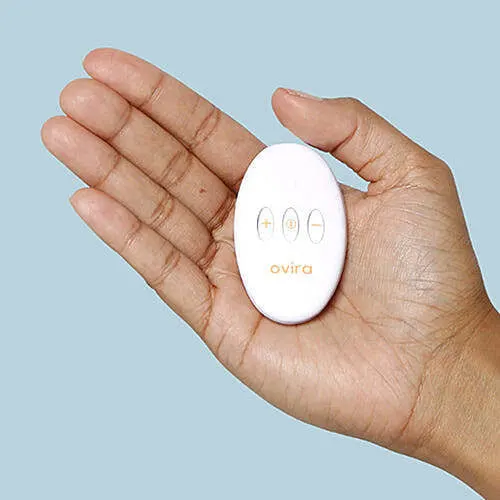Each month brings pain to most women of childbearing age. Discomfort from menstrual periods is commonplace and mostly manageable, but for many – hundreds of millions – severe, debilitating period pain and cramps are an ongoing reality. Worse, traditional treatments like heavy pain medication and the contraceptive pill can cause serious health problems, such as heart disease and stroke. Thankfully, Ovira has a solution: a science-backed future for period relief.
In Spain, they call it “defrosting the steak.” In France, they say Le Beaujolais Nouveau est arrive (“the wine has arrived”). In English, it’s the Curse or Shark Week.
In all, there are more than 5000 expressions for what no one likes to talk about – menstrual periods. Even though many of the euphemisms are humorous, they barely conceal the pain, embarrassment, and shame that many women feel during this normal biological event.
Known as dysmenorrhea, painful cramping is caused by the uterus contracting to shed its lining each month. If the uterus contracts too strongly, it can press against nearby blood vessels, cutting off the oxygen supply to muscle tissue. Pain is felt when part of the muscle briefly loses its supply of oxygen.
Many women – up to 10% — experience pain so severe that it interferes with daily activities. In fact, dysmenorrhea is the leading cause of school absences and lost working hours in women.
You May Also Like:
Debilitating Cramps Don’t Have to Ruin Your Month: Ovira Is the Off Switch for Period Pain is an original (HerHealthWatch) article.
Science has ignored this painful health issue
Menstruation is still surrounded by embarrassment and shame. A recent paper on the state of menstrual health laments that “menstruation continues to be shrouded in silence and stigma, and remains a neglected issue.”
Some argue that this ongoing stigma has led to silence in the scientific world. Despite the need for attention to this often incapacitating condition, relatively little research has been devoted to understanding or effectively treating dysmenorrhea. Investigators note that obtaining grants for new studies is challenging, in part because reviewers don’t think dysmenorrhea is worth studying.

Current treatments carry risks
Standard treatment for dysmenorrhea generally involves one of two modalities: the use of nonsteroidal anti-inflammatory painkillers (NSAIDs) or prescription oral contraceptives. Both treatments, however, can have significant side effects.
NSAIDs may cause drowsiness, dizziness, interactions with other medications, and stomach ulcers – which can lead to internal bleeding and anemia. Taken long-term, they can increase the risk of heart attacks and stroke. Moreover, NSAIDs are ineffective for about 18% of women.
Oral contraceptives also may have significantly negative effects on women’s long-term health. “The Pill” can carry a higher risk of stroke, may cause or exacerbate hypertension, and lead to follicular ovarian cysts and acne flares. There is also a chance of blood clots, which may increase the risk of a heart attack.
TENS units provide new relief
As an alternative to drugs, TENS units are now being used for period pain. TENS (transcutaneous electrical nerve stimulation) offers relief through small, battery-operated devices that send low-voltage currents into targeted areas of the body.
Patients can self-administer TENS therapy by placing electrodes (leads connected to sticky pads) on the surface of the skin above overactive nerves. These currents relieve pain by interrupting pain signals from traveling to the spinal cord and brain, and also by altering the perception of pain. They may also relax muscles and stimulate the production of endorphins, the body’s natural painkillers.
Since the early 1970s, TENS units have been used to address a variety of conditions, ranging from osteoarthritis, bursitis, and tendonitis, to diabetes-related neuropathy, back pain, sports injuries, and fibromyalgia.
Ovira: a new “off-switch” for period cramps
Starting only recently, TENS units have been used as an alternative method to alleviate menstrual pain. Ovira, an Australian enterprise, now offers a period cramp relief device that uses TENS therapy to provide relief.
Ovira founder Alice Williams blames social stigma about menstruation for the delay in the use of TENS units to treat dysmenorrhea.
“Traditionally, periods haven’t been discussed, and therefore there’s just been this quiet assumption that period pain is a part of life.”
“We have driverless cars and rocket ships,” she says, “but it seems like society forgot to address the billions of women experiencing debilitating period cramps every month. We need to be the change we want to see.”
Williams herself knows what it’s like to experience severe dysmenorrhea. Suffering from endometriosis, she endured years of incapacitating pain. Nothing helped: painkillers, contraceptive pills, hot water bottles, hours of mindfulness. She even states, “There seemed to be no option available to me that took into account my holistic and long-term well-being.” Williams knew women needed something else, and so Ovira was born.

Ovira: how it works
Ovira’s Period Cramp Relief Device is a small, lightweight, wearable TENS device that is silent and can be discreetly hidden under clothing. It works by running a small electrical current through two compression pads that are placed across the lower abdomen or back, depending on where the cramps are most intense. The pads are positioned over nerve roots that supply sensory fibers to the uterus and/or lower back. Once in place, stimulation from the currents overloads nerves, preventing pain signals from traveling to the brain and causing the muscles in the uterine area to relax.
The period cramp relief device is suitable for all ages and is designed to accommodate all body shapes and sizes.
Over 98% of Ovira users report a decrease in pain within 30 minutes of using their period cramp relief device. In addition, more than 92% of users state that they no longer rely on painkillers after using the Ovira device.

Ovira: user-friendly features
Unlike other modes of pain relief, the Ovira period cramp relief device is drug-free, non-invasive, and available without a prescription. Because individual pain levels vary, the unit features 40 intensity levels, with 12 hours of rechargeable battery life. It has also undergone clinical testing to ensure that it is completely safe to use for prolonged periods of time.
The Ovira device is medically approved in the U.S. and may be covered by insurance, depending on the user’s health plan.
Ovira: a holistic well-being program
In addition to providing relief from period pain, Ovira offers a full line of supplements geared to address the range of symptoms associated with menstruation, including PMS, acne, and cravings. PMS Relief, for example, is designed to regulate prolactin, the hormone responsible for causing uterine contractions.
Beyond providing relief from physical pain, Ovira aims to reduce emotional distress from periods.
“The more women I spoke to about this made it clear to me that it’s not even the physical pain that we hate the most,” emphasizes Williams. “It’s the emotional pain and isolation from feeling hopeless and misunderstood. These are very sensitive topics, and there’s so much trauma involved with them.”
That emotional pain has significant implications for the treatment of period pain. One study showed that in the United States, up to 86% of women with dysmenorrhea do not seek health care from clinicians. This is most likely because dysmenorrhea is not seen as a legitimate health issue by women, health care providers, or society. This leads to women and girls feeling embarrassed or afraid to seek care.

Combating a taboo
Williams adds that part of Ovira’s larger mission is to open up discussion about what has long been a forbidden subject. To that end, Ovira has established a social media presence that provides women with a safe space to openly talk about personal health matters that they have traditionally kept to themselves. That online community now includes eight million followers.
“For the first time ever in the last few years, periods aren’t something we need to be afraid of or ashamed of anymore,” Williams says.
“It’s time to change the way we think about women’s pain and make it a priority. We don’t need to live like this.”

Further reading:
STAT News: Current treatments for cramps aren’t cutting it. Why aren’t there better options?
Reuters: Women often keep impact of menstrual pain, bleeding to themselves
Cleveland Clinic: Dysmenorrhea: Menstrual Cramps, Causes & Treatments.
Important Note: The information contained in this article is for general informational purposes only, and should not be construed as health or medical advice, nor is it intended to diagnose, prevent, treat, or cure any disease or health condition. Before embarking on any diet, fitness regimen, or program of nutritional supplementation, it is advisable to consult your healthcare professional in order to determine its safety and probable efficacy in terms of your individual state of health.
Regarding Nutritional Supplements Or Other Non-Prescription Health Products: If any nutritional supplements or other non-prescription health products are mentioned in the foregoing article, any claims or statements made about them have not been evaluated by the U.S. Food and Drug Administration, and such nutritional supplements or other health products are not intended to diagnose, treat, cure, or prevent any disease.


